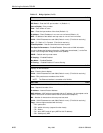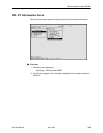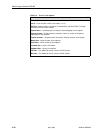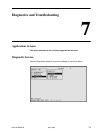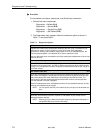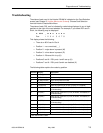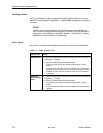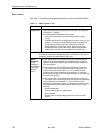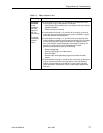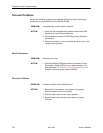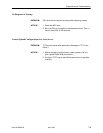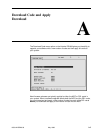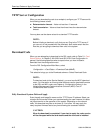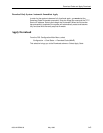
Diagnostics and Troubleshooting
7-6
8000-A2-GB26-00
May 1998
Minor Alarms
Use Table 7-3 to determine the appropriate action to take for each Minor Alarm.
Table 7-3. Minor Alarms (1 of 2)
Failure Type
Action
Config Error 1. Check the Selftest Results display by following the menu sequence:
Diagnostics
→
Selftest.
2. Do another Selftest (Reset) and check results.
– If the results are normal, the problem was transient. Log the
results.
– If Selftest results still show configuration corruption, there is a card
problem. The card’s nonvolatile RAM should be erased and the
configuration reentered. Perform a configuration download.
– If the configuration has not been saved, use reset and erase
NVRAM to force the card to the factory default. Enter the basic
default route to the MCC and reconfigure the card manually.
NOTE: The following are minor alarms where thresholds have been exceeded and
are primarily indications of degraded quality on the DSL loop. They are not
necessarily related to problems with the DSL card.
Margin
Threshold
(A trap
message is
sent if margin
falls below
selected
value.)
H If DSL speed is set to a Fixed Rate, you may choose to lower the
speed in the direction indicated by the threshold alarm (Fixed Up
Speed or Fixed Down Speed) to get a better Margin and improved
error performance.
H If DSL speed is set to Rate Adaptive and the Margin Threshold is
> 0, then this alarm is a warning that the loop has degraded. The
actual bit rate should still be above 10
-7
. This condition may be
temporary due to high temperature or humidity/rain, or it may be
permanent due to high noise from additional digital circuits installed in
the same cable bundle.
H If DSL speed is set to Rate Adaptive and the Margin Threshold is
< 0, then this alarm is a warning that the loop has seriously degraded.
The actual bit rate may be below 10
-7
. This condition may be
temporary or permanent. However, if it persists, the loop may have to
be reengineered for better performance by performing one of the
following:
– Remove bridge taps
– Change cable gauge on a cable section
– Run new cable
– Remove other noise-generating digital circuits from the cable
bundle



